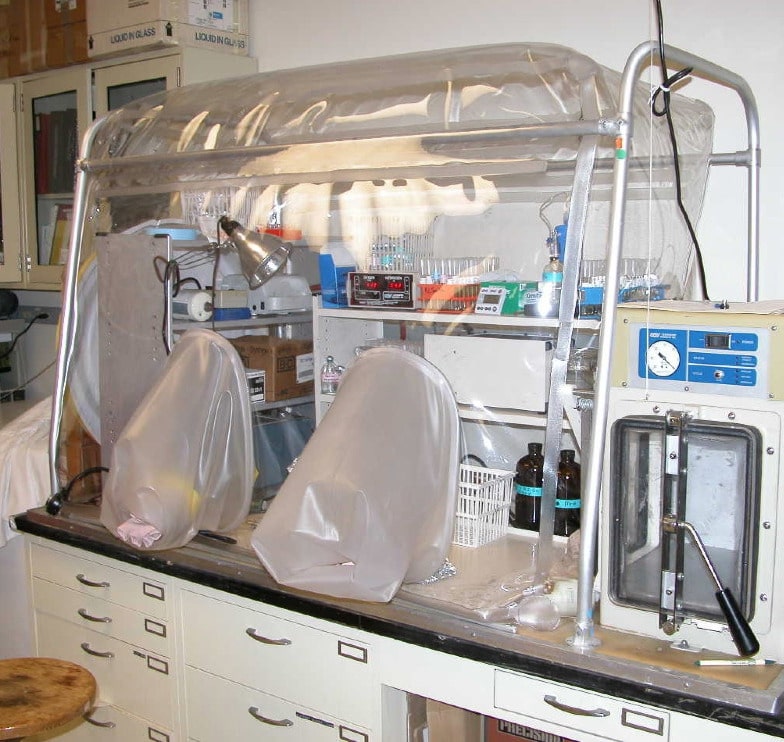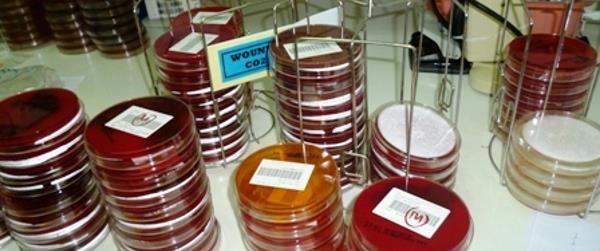Interested in whether your protein uses oxygen to mediate reactions? Wondering if oxygen is keeping your enzyme from its duty? Then what you need as an anaerobic tent!
These tips provide some basic knowledge to help you perform experiments using an anaerobic tent.
What is an anaerobic tent?
Most biologists who work in oxygen-free environments use anaerobic tents. These soft-sided vinyl chambers (and attached gloves) contain an inert mixture of gases and are given shape by a metal frame. They generally have a smaller footprint than glove boxes, and provide a greater range of motion during experiments. In addition, the anaerobic tent’s soft sides are more forgiving to changes in internal atmospheric pressure, though they are less sturdy overall.

Items (experimental materials) enter and exit both types of chamber through an attached airlock. Items within the airlock are subjected to multiple ‘cycles’ of alternating vacuum and repressurization using inert gas to purge as much excess oxygen as possible before they are brought into the main chamber. The interior of the anaerobic tent may or may not be sterile, depending on the needs of its users.
Establishing and maintaining an anaerobic environment is tedious and time-consuming. The misuse of an anaerobic tent, particularly the airlock, can cause both property damage and physical injury. Keeping in mind a few basic safety measures and good etiquette will keep you safe and on the good side of the team who normally uses the anaerobic tent.
Safety with anaerobic tents
1. Know how to cycle items through the airlock
The procedure for bringing items into or out of the anaerobic tent should be posted on or around the pump and gas tanks; regardless, you should still have one of the regular users walk you through the protocol. Save your memory: write down any relevant details that aren’t posted.
Airlock Tips
- Identify the locations of inlets/outlets in the purging system. Loose, light items such as Kimwipes can be sucked into the purging system, with catastrophic results.
- Don’t cycle open bottles containing solutions or powders through the airlock.
- Seal small bottles with abundant amounts of Parafilm and poke a few holes in the film with a needle.
- Stoppered bottles should be sealed with a tight-fitting (frequently screw-on) lid to keep the stopper from popping out. They should also be made as anaerobic as possible before entering the tent, using the techniques mentioned later.
2. Know where the air monitoring gauges are, and keep an eye on them during your experiment
Ask one of the regular users of the anaerobic system what the expected gas ratios are, and record the appropriate minimum and maximum acceptable numbers. Many systems have alarms to warn users when the oxygen concentration becomes too high. Ask a lab member to demonstrate, but don’t depend on the alarm; be aware of oxygen levels during your experiment.
Etiquette for using an anaerobic tent
1. Plan ahead
It takes time for items that have been kept on the shelf in the lab to equilibrate in an anaerobic environment, and it takes time for the anaerobic tent to purge oxygen carried in with each set of fresh items. Plastics usually take a couple of days to ‘breathe’ off the oxygen adhering to their porous surfaces.
Any equipment (probes, etc.), that you want to use in the tent will also need to be brought in. Make sure that your labmates won’t need to use them and there is a power outlet available in the tent. Depending on the equipment’s composition, it may also need a day or two to off-gas before you start.
If the anaerobic tent is used as a sterile environment, make sure that it stays that way—prepare your materials appropriately and practice aseptic technique as necessary.
2. Do not leave large bottles of solution open in the tent for an extended period of time
If you won’t be using the solution for more than a day or so, stopper the bottle tightly to prevent evaporation. Water vapor can cause mold as well as contribute to oxygen levels.
3. Remove your supplies and experimental waste as soon as possible once you are finished with your experiment
If you are running a multi-day experiment, remove waste materials at least daily to keep the tent clean and minimize the possible contamination sources. Strong acids and bases are not nice to the inside of the anaerobic box, and water evaporates.
4. If you plan to use the tent for more than a few days, offer to help with minor maintenance
Anaerobic boxes require regular upkeep, even when they are not in use. Be sure to ask if there is any light regular maintenance you can perform while using the tent. You may be asked to replace the hygroscopic pellets or palladium catalyst, a task generally performed every few days. You may not need to do anything, but it doesn’t hurt to ask.
Pro tips for anaerobic solution prep
If you only need a small amount of solution, check anaerobic solvents already in the tent.
Large-volume solutions (buffers, etc.) created in room atmosphere should have as much excess oxygen removed as possible before they are introduced to the anaerobic tent. Below are details on how to perform this, but don’t hesitate to ask a lab member for help with this process!
- Stopper the bottle and run an appropriate inert gas through the solution as it is vigorously stirred. Be sure you provide an avenue for the oxygen to escape!
- Once the bottle has been degassed for an hour or so, seal it (usually with a screw-top lid) and cycle it into the tent.
- Once the system appears stable, let the solution stir in the tent without the stopper for another couple of hours or overnight. Keep an eye on the tent’s oxygen levels during this process, and restopper the bottle once you are done.
Performing an experiment under anaerobic conditions introduces many factors into your experiment (including how to handle microcentrifuge tubes while wearing enormous kitchen gloves), but can also provide you with invaluable information about whether your protein requires oxygen or its absence.
These tips should help make sure your experiment is a success!







